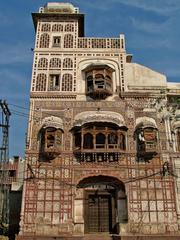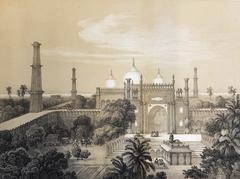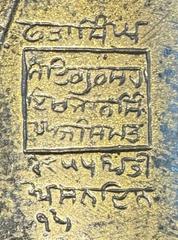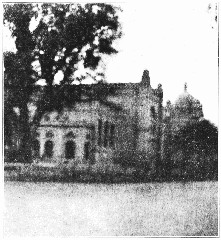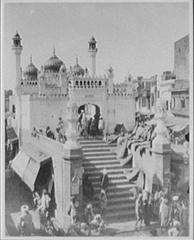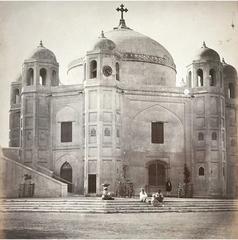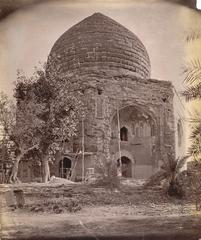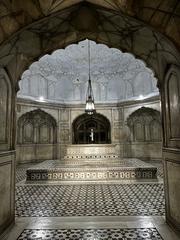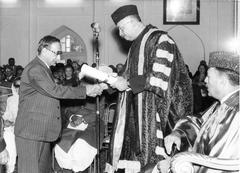Cypress Tomb Visiting Hours, Tickets, and Complete Guide to Lahore’s Historical Gem
Date: 04/07/2025
Introduction: Exploring the Cypress Tomb (Saru Wala Maqbara)
Hidden in the historic Begumpura neighborhood of Lahore, the Cypress Tomb—locally known as Saru Wala Maqbara—stands as a striking testament to the city’s rich Mughal heritage. Built in 1745 for Begum Sharf-un-Nisa, the sister of Nawab Zakariya Khan, the then-governor of Lahore, this monument is celebrated for its distinctive tower-like form, ethereal blue and white glazed tilework, and evocative cypress tree motifs symbolizing immortality and spiritual resilience. Unlike Lahore’s more famed tombs and mosques, the Cypress Tomb offers visitors a serene, off-the-beaten-path experience, while also reflecting the significant yet often-overlooked roles women played in Mughal society.
This detailed guide covers everything you need to plan your visit: historical background, architectural highlights, practical information on hours and tickets, accessibility, photography tips, nearby attractions, and cultural etiquette. Whether you’re a history enthusiast, architecture lover, or curious traveler, the Cypress Tomb reveals a unique chapter of Lahore’s vibrant past.
For additional perspectives, see Parhlo, Locally Lahore, and Dawn.
Table of Contents
- Introduction
- Historical Background and Context
- Architectural and Artistic Significance
- Visiting Information: Hours, Tickets, and Access
- Cultural Etiquette and Visitor Tips
- Nearby Historical Attractions
- Frequently Asked Questions (FAQs)
- Visuals and Media
- Conclusion
- Sources and Further Reading
Historical Background and Context
Commissioned in 1745, the Cypress Tomb was built as the mausoleum for Begum Sharf-un-Nisa, an influential Mughal noblewoman and sister to Nawab Zakariya Khan, governor of Lahore during the reign of Emperor Muhammad Shah (Parhlo). This period marked the waning decades of Mughal authority, but Lahore remained a thriving cultural center.
Begum Sharf-un-Nisa’s burial here reflects the tradition of commemorating not just male rulers, but also elite women who played critical roles in society. The tomb’s location in Begumpura—historically associated with female patronage—underscores the importance of women in Lahore’s Mughal-era urban fabric (Heritage Punjab).
Architectural and Artistic Significance
Unique Structural Form
Unlike the domed mausoleums common in Mughal architecture, the Cypress Tomb features a solid, square-plan tower that tapers upward, creating a distinctive vertical profile (Locally Lahore). The burial chamber is elevated about 16–25 feet above ground and was historically accessible only by a movable ladder. This unusual design respected Sharf-un-Nisa Begum’s observance of purdah, ensuring her privacy even after death; all openings were sealed posthumously, resulting in the tomb’s blank, fortress-like lower walls.
Decorative Features and Symbolism
The monument’s most notable artistic element is its spectacular blue and white glazed tilework. Each side of the upper façade showcases cypress tree motifs surrounded by stylized floral patterns. The cypress, a symbol of eternity in Persian and Mughal art, reinforces the tomb’s spiritual significance (Locally Lahore). A band of tiles around the dome’s neck bears inscriptions of Allah’s attributes, integrating religious symbolism into the design.
The dome itself is a four-sided pyramid, adorned with zigzag tile patterns—a rare motif in Lahore’s funerary architecture. A projecting chajja (eave) encircles the top, adding both visual interest and protection from the elements.
Construction and Craftsmanship
Constructed primarily of brick, the tomb’s battered (sloping) walls provide structural stability and a unique silhouette. The vibrant glazed tiles, confirmed as locally manufactured, reflect indigenous craftsmanship and regional artistic traditions (Dawn). The site’s original gardens and water features have largely vanished due to urban encroachment, but the tomb’s solemn grandeur endures.
Visiting Information: Hours, Tickets, and Access
Location and How to Get There
The Cypress Tomb is located in Begumpura, about 200 meters north of the Tomb of Dai Anga, off the Grand Trunk Road. It is set back from the main road and accessed via narrow lanes, best navigated on foot or by rickshaw (Historian2016). The site is about a 15-minute drive from central landmarks like Lahore Fort and Badshahi Mosque.
Visiting Hours
- Open Daily: 8:00 AM – 6:00 PM (daylight hours)
- Best Time to Visit: Early morning or late afternoon for pleasant temperatures and optimal photography light.
Tickets and Entry Fees
- Entry: Free of charge; donations for site maintenance are appreciated.
- Guided Tours: No official guides; knowledgeable local guides may be hired, or you can join broader heritage tours that include the site.
Accessibility
- The tomb’s interior and elevated burial chamber are sealed and not accessible to visitors.
- The exterior can be explored on foot, but pathways are uneven and not wheelchair-accessible.
- No on-site restrooms, shops, or visitor centers; plan ahead for essentials.
Cultural Etiquette and Visitor Tips
- Dress modestly: Respect local customs by wearing conservative attire.
- Photography: Allowed for the exterior—avoid photographing local residents without permission.
- Behavior: Maintain a respectful, quiet demeanor; remove shoes if stepping onto the tomb’s platform.
- Safety: The site is generally safe during the day; avoid solitary visits after dark.
- Engage respectfully: Local residents may share stories—polite interaction enhances your visit.
Nearby Historical Attractions
Enhance your heritage tour by visiting these nearby Lahore sites:
- Tomb of Dai Anga: Another Mughal-era mausoleum just south of the Cypress Tomb.
- Shalimar Gardens: Historic Mughal gardens showcasing terraced landscapes and water features.
- Badshahi Mosque & Lahore Fort: Iconic Mughal monuments a short drive away.
- Begumpura Village: Explore local mosques, serai (rest house), and Sikh-era gateways for a broader view of the area’s layered history.
Local eateries and markets offer authentic culinary experiences—wear comfortable shoes and carry water, as amenities near the tomb are limited.
Frequently Asked Questions (FAQs)
Q: What are the visiting hours of the Cypress Tomb?
A: Open daily from 8:00 AM to 6:00 PM during daylight hours.
Q: Is there an entry fee?
A: No, entry is free; donations for maintenance are welcome.
Q: How can I reach the Cypress Tomb from central Lahore?
A: By taxi, rickshaw, or ride-hailing services; about 15 minutes from Lahore Fort.
Q: Are guided tours available?
A: Not officially, but local guides may be hired and the tomb is included in some broader heritage tours.
Q: Is the tomb wheelchair accessible?
A: Accessibility is limited due to uneven ground and lack of ramps.
Q: Can I photograph the tomb?
A: Yes, exterior photography is permitted; please be discreet and respectful.
Visuals and Media
- Exterior view of the Cypress Tomb with its pyramidal dome and glazed tilework. (Alt: “Cypress Tomb Lahore pyramidal dome and glazed tilework”)
- Close-up of cypress tree tile motifs. (Alt: “Cypress tree tile motifs on Cypress Tomb Lahore”)
- Map showing the location of the tomb relative to other Mughal landmarks.
See additional images on Daily Times and TripJive.
Conclusion
The Cypress Tomb (Saru Wala Maqbara) is a remarkable yet often overlooked monument, offering visitors a unique perspective on Mughal funerary architecture, artistry, and the historical influence of women in 18th-century Lahore. Its singular tower-like form, intricate symbolic tilework, and tranquil setting in Begumpura make it a must-visit for those seeking to experience Lahore’s hidden heritage.
Despite challenges from urban encroachment and limited visitor facilities, ongoing conservation efforts and growing community awareness are helping preserve this vital piece of history. By visiting respectfully and supporting local heritage initiatives, you contribute to the tomb’s continued legacy.
For more information, travel tips, and heritage guides, download the Audiala app and follow us on social media. Make the most of your Lahore journey by exploring this and other historical treasures.
Sources and Further Reading
- Parhlo: Historical Places in Lahore You Might Not Know About
- Locally Lahore: Cypress Tomb Sarvwala Maqbara
- Dawn: Visiting Cypress Tomb in Lahore—Hours, Tickets, and Historical Insights
- Daily Times: Lahore’s Cypress—A Unique Tomb That Lies 16 Feet Above the Ground Level
- Heritage Punjab: Tomb of Sharf-un-Nisa Begum Lahore
- Pakistan Guided Tours: Tomb of Cyprus Saru Wala Maqbra
- TripJive: Lahore for History Buffs—Hidden Gems to Explore
